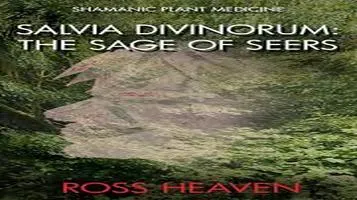A Comprehensive Review of Salvia Divinorum: The Enigmatic Sage
Salvia, commonly known as sage, is a diverse genus of plants belonging to the Lamiaceae family. This genus encompasses nearly 1,000 species, distributed across various regions, including Central and South America, Central Asia, and the Mediterranean. Known for their vibrant flowers and aromatic foliage, salvias are popular both in ornamental gardening and culinary uses. The most recognized species, Salvia officinalis, is widely used as a culinary herb, prized for its distinct, earthy flavor. Beyond its culinary applications, Salvia has historical significance in traditional medicine, believed to possess anti-inflammatory and antioxidant properties. The plant thrives in sunny locations with well-drained soil, making it a versatile choice for gardens. Its vibrant blooms, ranging in colors from blue to red, also attract pollinators like bees and butterflies.

Salvia divinorum, commonly known simply as Salvia, is a perennial herbaceous plant belonging to the mint family, Lamiaceae. Indigenous to the cloud forests of the Sierra Mazateca in Oaxaca, Mexico, Salvia has been used for centuries by the Mazatec shamans for its potent psychoactive properties. In recent years, it has gained popularity in the West, primarily for its unique and intense hallucinogenic effects. This review aims to provide a comprehensive overview of Salvia, exploring its history, usage, effects, legality, and cultural implications.
Historical and Cultural Background
The history of Salvia is deeply rooted in the spiritual practices of the Mazatec people. Traditionally, it was used in healing ceremonies, divination, and other spiritual rituals. The leaves were either chewed or brewed into a tea, allowing the shamans to enter a trance-like state, which they believed facilitated communication with spiritual entities and provided insights into the human condition. This sacred use underscores the plant's significance in Mazatec culture, where it was seen as a conduit to the divine.
Chemical Composition and Mechanism of Action
The primary psychoactive compound in Salvia is salvinorin A, a potent kappa-opioid receptor agonist. Unlike most hallucinogens, which typically act on serotonin receptors, salvinorin A's unique mechanism of action contributes to its distinctive effects. The compound is effective at extremely low doses, making it one of the most potent naturally occurring hallucinogens. When consumed, salvinorin A rapidly crosses the blood-brain barrier, leading to a quick onset of effects.
Methods of Consumption
Salvia can be consumed in various ways, each offering a different intensity and duration of effects. The most common methods include:
1. Smoking: Dried Salvia leaves or extracts are smoked in a pipe or bong. This method provides a rapid onset of effects, typically within 30 seconds to 2 minutes, with the experience lasting around 10-20 minutes.
2. Chewing (Quid): Fresh or rehydrated leaves are chewed and held in the mouth to allow absorption through the oral mucosa. This method produces a milder and more prolonged effect, lasting up to an hour.
3. Sublingual Tinctures: Liquid extracts are held under the tongue for absorption. This method also offers a longer, milder experience compared to smoking.
Effects and Experience
The effects of Salvia are often described as profoundly intense and vary significantly from other hallucinogens. Users report a range of experiences, from vivid hallucinations and altered perceptions of time and space to deep introspective and mystical experiences. Common effects include:
- Visual and Auditory Hallucinations: Users may see intricate patterns, vibrant colors, and experience auditory distortions.
- Dissociation: A sense of detachment from oneself, feeling as though they are observing their body from an external perspective.
- Spatial Disorientation: A distorted sense of space and body, often described as feeling pulled, twisted, or stretched.
- Emotional Shifts: Rapid changes in mood, ranging from euphoria to anxiety or fear.
Due to the intensity and unpredictability of these effects, Salvia is often considered a challenging substance, especially for inexperienced users.
Legality and Regulation
Salvia's legal status varies worldwide. In the United States, it is not federally controlled but is regulated in several states. Some countries, such as Australia and many European nations, have classified it as a controlled substance, making its sale and possession illegal. The patchwork of regulations reflects ongoing debates about its safety and potential for abuse.
Safety and Precautions
While Salvia is not known to be physically addictive, its intense psychological effects necessitate caution. Potential risks include:
- Psychological Distress: The overwhelming nature of the experience can lead to anxiety, panic, or psychosis, particularly in individuals with a history of mental health issues.
- Accidents and Injuries: Due to impaired motor control and altered reality, there is a risk of physical harm if the user moves around during the experience.
- Set and Setting: As with any psychedelic, the user's mindset and environment play a crucial role in shaping the experience. A safe, comfortable setting with a sober sitter is recommended.
Conclusion
Salvia divinorum remains a fascinating and enigmatic plant with a rich cultural heritage and unique psychoactive properties. Its ability to induce profound, otherworldly experiences has captivated both indigenous shamans and contemporary psychonauts. However, its intense and unpredictable effects warrant respect and caution. Whether explored for spiritual insight, psychological exploration, or sheer curiosity, Salvia demands a mindful and informed approach. As research continues to unravel its mysteries, Salvia stands as a testament to the diverse and potent potential of the natural world.



![Comprehensive Review of [Brand Name] Pest Control Spray: A Reliable Solution for a Pest-Free Home](https://img.worth-buying.com/ccsimg/dcs/images/97d2e3af880e3c51cc1116119478397b.webp)


